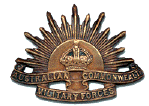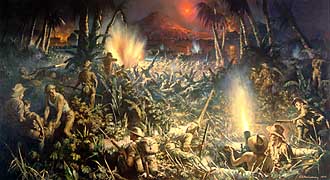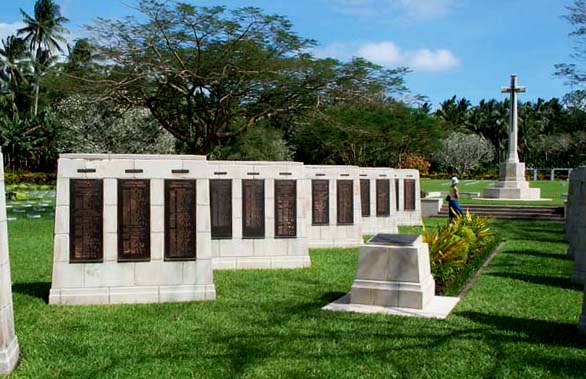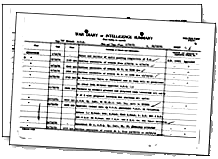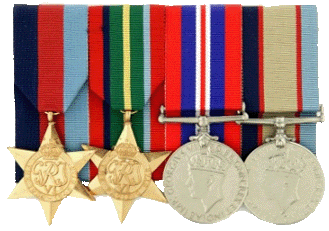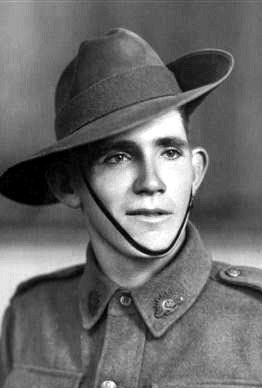January 1942 - The Fate of Lark Force
The 2/22nd Infantry Battalion, part of the 23rd Brigade of the 8th Division, was raised on 1 July 1940, under the command of Lieutenant Colonel Howard Carr. The battalion was initially headquartered at Victoria Barracks in Melbourne but on 11 July moved to Trawool in central Victoria for training. On 24 September the 2/22nd began to move to Bonegilla, near Wodonga on the New South Wales–Victoria border. The battalion made the 235 km journey on foot and arrived on 4 October. Training soon resumed, occupying the battalion until it entrained for Sydney, ultimately bound for New Britain on 17 April 1941.
The 2/22nd arrived at Rabaul, the administrative centre of New Britain, on 26 April. It combined with the local unit of the New Guinea Volunteer Rifles, a coastal defence battery, an anti-aircraft battery, and elements of the 2/10th Field Ambulance and 17th Anti-tank Battery to form Lark Force. The force would later be supported by 24 Squadron, Royal Australian Air Force (RAAF). Its role was to protect the airfields at Lakunai and Vunakanau, and the seaplane base at Rabaul, as well as provide early warning of Japanese movements through the islands to Australia’s north. Like the other “bird forces’ deployed to Australia’s north, Lark Force was ill-equipped and likely to be overwhelmed by enemy attack. Nonetheless, the 2/22nd spent the next months constructing defences and training for operation in a tropical environment.
Japanese bombing of New Britain began in early January 1942, increasing in intensity as the month continued. By the morning of 22 January 24 Squadron was virtually destroyed and its three remaining aircraft were withdrawn. With no use for the airstrips, both were destroyed and Lark Force withdrew from Rabaul, waiting on the western shores of Blanche Bay for the inevitable Japanese landings.
These began at 1 am on 23 January. By 9 am, communication failures and the overwhelming Japanese strength – 5,000 troops compared to the 1,400 of Lark Force – destroyed the cohesion of the Australian defence. The Lark Force commander, Colonel John Scanlan, ordered a withdrawl on the morning of 23 January on the basis of “every man for himself”. Unprepared for retreat, chaos ensued and Lark Force disintegrated.
In ensuing days, 2/22nd parties, ranging from company-strength down to pairs and individuals, sought escape along New Britain’s north and south coasts. Some found small boats and got away under their own auspices; others were picked up by larger vessels operating from New Guinea. Around 400 members of Lark Force managed to return to Australia, 300 of which were members of the 2/22nd.
Approximately 160 Australians captured by the Japanese while trying to escape were massacred at Tol Plantation and another 836 were interned as prisoners of war. On 22 June 1942 a group of Australian prisoners and European civilians were loaded aboard the Montevideo Maru to be transported to Hainan Island. The ship was sunk on 1 July by the submarine USS Sturgeon off the Phillipines, killing all 1,053 prisoners and civilian internees. The Australian officers and a small number of civilians who were left behind at Rabual were subsequently shipped to Japan on the Natuno Maru, were they remained until liberated in September 1945.
The 2/22nd was never re-raised.
Rabaul memorial
It is predominantly the story of Lark Force, the small garrison of 1400 Australians that faced the full onslaught of the Japanese invasion of New Britain in January 1942.
At the beginning of the war in the Pacific, Rabaul was Australia's frontline, an Australian outpost that was closer to the Japanese military base at Truk than it was to Cairns. Lark Force - men of the 2/22nd Battalion, Australian Imperial Force, and support units, including six Australian nurses - had been sent to Rabaul in April 1941 amid rising fears of Japanese aggression. But from the start it was very much a doomed cause.
Just days after Japan entered the war, the Chiefs of Staff in Australia conceded that a Japanese attack would be "beyond the capacity of the small garrison to resist". However, it was decided that Lark Force should not be reinforced and there would be no withdrawal. On 22-23 January 1942, the Japanese came.
The men of Lark Force should be remembered as the first Australian garrison to face the Japanese on Australian territory and for those tragedies of captivity which prevented the majority of them from ever seeing home again.
The Rabaul Memorial: commemorates over 1,200 members of the Australian Army (including personnel of the New Guinea and Papuan local forces and constabulary) and the Royal Australian Air Force, who lost their lives in New Britain and New Ireland in January and February 1942, and in New Britain from November 1944 to August 1945, and who have no known grave. Men of the Royal Australian Navy who lost their lives in the south-western Pacific region and who have no graves but the sea, are commemorated on Plymouth Naval Memorial in England along with many of their comrades of the Royal Navy and other Commonwealth Naval Forces.
The Memorial takes the form of an avenue of stone pylons leading from the entrance building of the cemetery to the Cross of Sacrifice. Bronze panels bearing the names are affixed to the faces of the pylons. A central stone lectern at the commencement of the avenue carries a bronze plate with the following dedicatory inscription:
AD MAJOREM DEI GLORIAM IN THIS PLACE ARE RECORDED THE NAMES OF OFFICERS AND MEN OF THE BRITISH COMMONWEALTH OF NATIONS WHO DIED DURING THE 1939-1945 WAR IN THE NEW BRITAIN AREA, ON LAND, AT SEA AND IN THE AIR, BUT TO WHOM THE FORTUNES OF WAR DENIED THE KNOWN AND HONOURED BURIAL GIVEN TO THEIR COMRADES IN DEATH.







